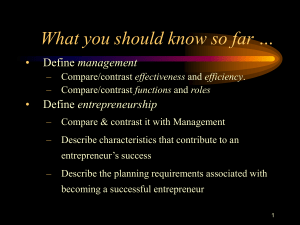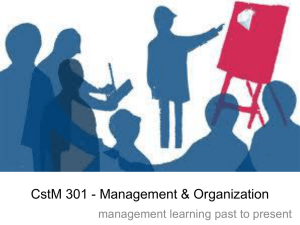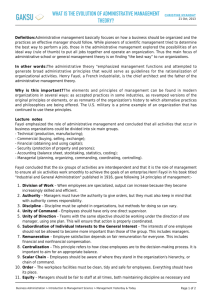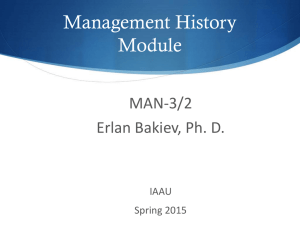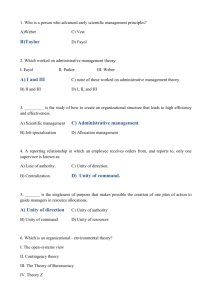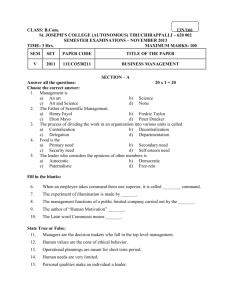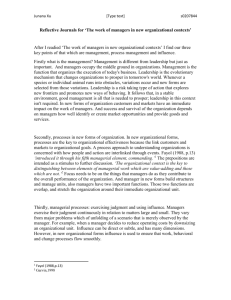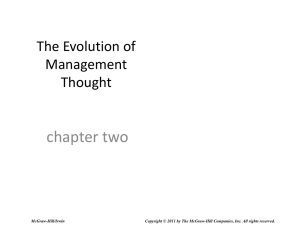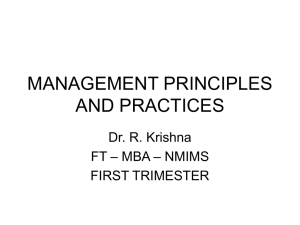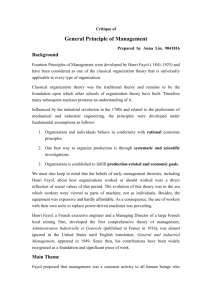The Different Approaches and Systems of Management
advertisement
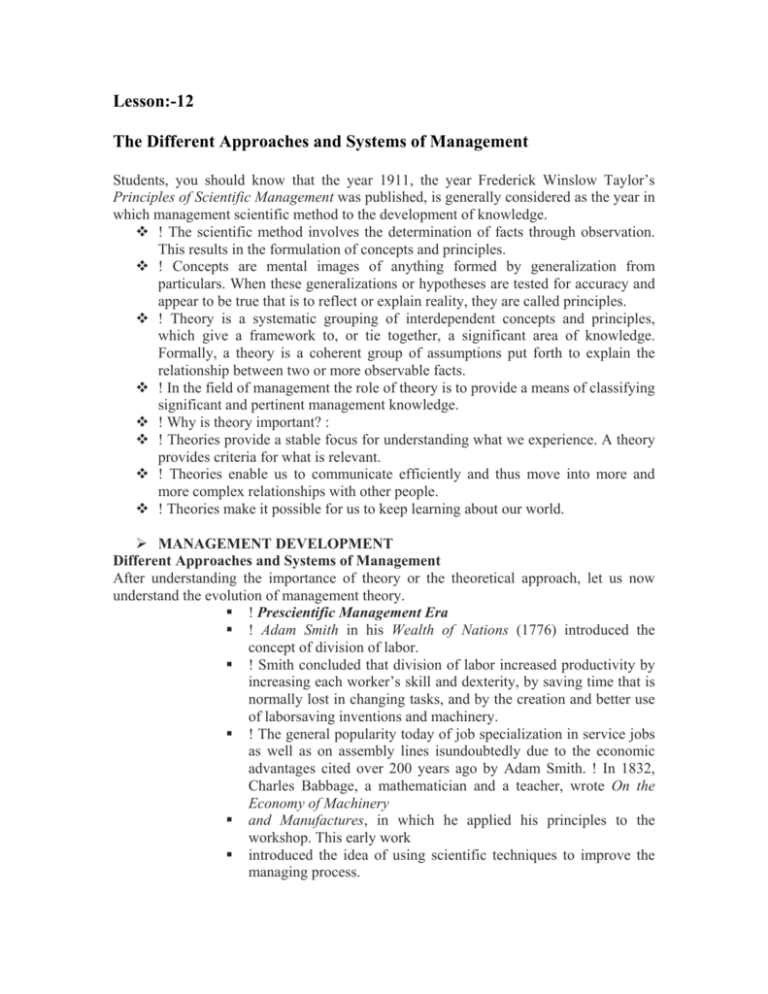
Lesson:-12 The Different Approaches and Systems of Management Students, you should know that the year 1911, the year Frederick Winslow Taylor’s Principles of Scientific Management was published, is generally considered as the year in which management scientific method to the development of knowledge. ! The scientific method involves the determination of facts through observation. This results in the formulation of concepts and principles. ! Concepts are mental images of anything formed by generalization from particulars. When these generalizations or hypotheses are tested for accuracy and appear to be true that is to reflect or explain reality, they are called principles. ! Theory is a systematic grouping of interdependent concepts and principles, which give a framework to, or tie together, a significant area of knowledge. Formally, a theory is a coherent group of assumptions put forth to explain the relationship between two or more observable facts. ! In the field of management the role of theory is to provide a means of classifying significant and pertinent management knowledge. ! Why is theory important? : ! Theories provide a stable focus for understanding what we experience. A theory provides criteria for what is relevant. ! Theories enable us to communicate efficiently and thus move into more and more complex relationships with other people. ! Theories make it possible for us to keep learning about our world. MANAGEMENT DEVELOPMENT Different Approaches and Systems of Management After understanding the importance of theory or the theoretical approach, let us now understand the evolution of management theory. ! Prescientific Management Era ! Adam Smith in his Wealth of Nations (1776) introduced the concept of division of labor. ! Smith concluded that division of labor increased productivity by increasing each worker’s skill and dexterity, by saving time that is normally lost in changing tasks, and by the creation and better use of laborsaving inventions and machinery. ! The general popularity today of job specialization in service jobs as well as on assembly lines isundoubtedly due to the economic advantages cited over 200 years ago by Adam Smith. ! In 1832, Charles Babbage, a mathematician and a teacher, wrote On the Economy of Machinery and Manufactures, in which he applied his principles to the workshop. This early work introduced the idea of using scientific techniques to improve the managing process. ! The theoretical foundations of management lie in the classical approach to management, whichsought to formulate rational principles that would make organizations more efficient. ! The classical approach to management consists of two subcategories: ! Scientific management approach looked at the field from the perspective of how to improve theproductivity of operative personnel. ! General administrative approach was concerned with the overall organization and how to make it more effective. ! Scientific Management Approach • ! Most writers agree that the origin of the concentrated study of management was the work performed by Frederick W. Taylor and his associates during the scientific management movement that developed around 1900. • ! Frederic W. Taylor (1865-1915) • ! Frederic Taylor pioneered scientific management, which suggested that systematic investigation could indicate proper methods, standards and timings for each operation in an organization’s activities. • ! The scientific management method proposed by Taylor was based on the notion that there was a single “best way” to fulfill a particular job. The responsibility of management was to select, train, and help workers to perform their jobs properly. • ! The job of management was to plan and control the work. The responsibility of workers wassimply to accept the new methods and perform accordingly. • ! The practical application of this approach was to break each job down into its smallest and simplest component parts or ‘motions’: each single motion in effect became a separate specialized‘job’ to be allocated to a separate worker. Workers were selected and trained to perform such jobs in the most efficient way possible, eliminating all wasted motions or unnecessary physical motion. • ! Henry L. Gantt (1861-1919) • • • • ! Henry L. Gantt, a contemporary and associate of Taylor, emphasized the psychology of the worker and the importance of morale in production. ! Gantt devised a wage payment system, which stimulated foremen and workers to strive for improvement in work practices. ! Gantt also developed a charting system for scheduling production, the “Gantt chart” that remains the basis for modern scheduling techniques. ! Frank and Lillian Gilbreth (1868-1924 and 1878-1972) • • • • • • • • • • • • • • • • • • • • • • • ! Frank and Lillian Gilbreth, the husband-and-wife team made their contribution in fatigue and motion studies to eliminate wasteful hand-and-body motions. ! The Gilbreths also experimented with the design and use of the proper tools and equipment foroptimizing work performance. ! The Gilbreths were among the first to use motion picture films to study hand-and-body motions. ! The Gilbreths also devised a classification scheme to label 17 basic hand motions, which theycalled therbligs. ! Contributions of Scientific Management: ! Assembly lines concept to produce large quantities faster. ! Initiated the careful study of tasks and jobs. ! Today’s reengineering concept is similar. ! Demonstrated importance of compensation for performance. ! Its efficiency techniques are applied to tasks even today. ! Limitations of Scientific Management: ! Regarded workers as uninformed and ignored their ideas. ! Dehumanization of workers. ! More stress on quantity rather than quality. ! Did not appreciate the higher needs of workers. ! Did not acknowledge differences among individuals. ! More importance to method rather than skill. ! General Administrative Approach ! Henri Fayol (1841-1925) ! Henri Fayol was a French industrialist who put forward who put forward and popularized the concept of the ‘universality of management principles’, the idea that all organizations could bestructured and managed according to certain rational principles. ! Fayol divided a commercial organization’s activities into the six basic elements of technical, commercial, accounting, financial, security, and management. Fayol described the practice of management as distinct from the other business activities. ! He argued that management was an activity common to all human undertakings: in business, ingovernment, and even in the home. ! In his most significant work, General and Industrial Management, Fayol discussed 14 general principles of management which he felt could be applied in any organizational setting. Several of these principles are part of management philosophy today. • Before Fayol, it was generally believed that “managers are born, not made.” Fayol insisted, however that management was a skill like any other – one that could be taught once the principles of management were understood. FAYOL’S 14 PRINCIPLES OF MANAGEMENT 1. Division of Labor. The most people specialties, the more efficiently they can perform their work. This principle is epitomized by the modern assembly line. 2. Authority. Managers must give orders so that they can get things done. While their formalauthority gives them the right to command, managers will not always compel obedience unless they have personal authority (such as relevant expertise) as well. 3. Discipline. Members in an organization need to respect the rules and agreements that govern the organization. To Fayol, discipline results from good leadership at all levels of the organization, fair agreements (such as provisions for rewarding superior performance), and judiciously enforced penalties for infractions. 4. Unity of Command. Each employee must receive instructions from only one person. Fayol believed that when an employee reported to more than one manager, conflicts in instructions and confusion of authority would result. 5. Unity of Direction. Those operations within the organization that have the same objective should be directed by only one manager using one plan. For example, the personnel department in a company should not have two directors, each with a different hiring policy. 6. Subordination of Individual Interest to the Common Good. In any undertaking, the interests of employees should not take precedence over the interests of the organization as a whole. 7. Remuneration. Compensation for work done should be fair to both employees and employers. 8. Centralization. Decreasing the role of subordinates in decision-making is centralization; increasing their role is decentralization. Fayol believed that managers should retain final responsibility, but should at the same time give their subordinates enough authority to do their jobs properly. The problem is to find the proper degree of centralization in each case. 9. The Hierarchy. The line of authority in an organization – often represented to day by the neat boxes and lines of the organization chart – runs in order of rank from top management to the lowest level of the enterprise. 10. Order. Materials and people should be in the right place at the right time. People, in particular, should be in the jobs or positions they are most suited to. 11. Equity. Managers should be both friendly and fair to their subordinates. 12. Stability of Staff. A high employee turnover rate undermines the efficient functioning of an organization. 13. Initiative. Subordinates should be given the freedom to conceive and carry out their plans, even though some mistakes may results. 14. Esprit de Corps. Promoting team spirit will give the organization a sense of unity. To Fayol, even small factors should help to develop the spirit. He suggested, for example, the use of verbal communication instead of formal, written communication whenever possible. ! Max Weber (1864-1920) 1. ! Max Weber, a German sociologist, developed a theory of authority structures and described organizational activity on the basis of authority relations. 2. ! He described an ideal type of organization that he called a bureaucracy, characterized by division of labor, a clearly defined hierarchy, detailed rules and regulations, and impersonal relationships. 3. ! Weber also believed that technical competence should be emphasized and that performance evaluations should be made entirely on the basis of merit. 4. ! Weber recognized that this ideal bureaucracy did not exist in reality. He used it as a basis for theorizing about work and the way work could be done in large groups. His theory became the design prototype for many of today’s large organizations. 5. ! Mary Parker Follett (1868-1933) 6. ! Follett introduced many new elements to the classical management approach especially in theareas of human relations and organizational structure. The trends she initiated were furtherdeveloped in the then emerging behavioral and management science approaches. 7. ! Follett recognized that organizations could be viewed from the perspective of individual and group behavior. She was convinced that no one could become a whole person except as a member of a group; human beings grew through their relationships with others in organizations. 8. The manager’s job was to harmonize and coordinate group efforts. 9. !· Follett asserted that managers and workers should view themselves as partnersas part of a common group. She proposed that managers should rely more on their expertise and knowledgeto lead subordinates rather than on the formal authority of their position. Her approach stressed the importance of people rather than engineering techniques. 10. ! Follett addressed issues that are timely today, such as ethics, power, and how to lead in a way that encourages employees to give their best. 11. ! Chester Barnard (1886-1961) 12. ! Chester Barnard expressed his views in his book The Functions of the Executive (1938). 13. ! Barnard saw organizations as social systems that require human cooperation. A major part of an organization’s success depended on the cooperation of its employees. He went further to emphasizethe organization as the cooperative enterprise of individuals working together in groups. 14. !· One of Barnard’s significant contributions was the informal organization. The informal organization occurs in all formal organizations and includes cliques and naturally occurring social groupings. 15. Barnard argued that organizations are not machines and informal relationships are powerful forces that can help the organization if properly managed. 16. ! Another significant contribution of Barnard was the acceptance theory of authority, which states that people have free will and can choose whether to follow management orders. People typicallyfollow orders because they perceive positive benefit to themselves, but they do have achoice. He proposed that an enterprise can operate efficiently and survive only when the organization’s goals are kept in balance with the aims and needs of the individuals working for it. 17. ! Barnard also argued that success of an enterprise depended on maintaining good relations with the people and institutions with whom the organization regularly interacted. By recognizing the organization’s dependence on investors, suppliers, customers, and other stakeholders, Barnard introduced the idea that managers had to examine the external environment and then adjust the organization to maintain a state of equilibrium. 18. ! The current interest in building cooperative work groups, making business firms more socially 19. responsible, and matching organizational strategies to opportunities in the environment can be traced to ideas originally proposed by Barnard. (A)Behavioral Approach 1. ! Robert Owen was a successful Scottish businessman who was repulsed by the harsh practices he found in factories in his time. He chided factory owners for treating their equipment better than their employees. He was more than a hundred years ahead of his time when he argued, in1825, for regulated hours of work for all, child labor laws, public education, company-furnishedtools and equipment, and business involvement in community projects. 2. ! The behavioral approach emerged partly because the classical approach did not achieve sufficient production efficiency and workplace harmony. There was increased interest in helping managers deal more effectively with the “people side” of their organizations. 3. ! Hugo Munsterberg created the field of industrial psychology-the scientific study of individuals at work to maximize their productivity and adjustment. 4. ! In his work, Psychology and Industrial Efficiency (1913) he suggested the use of psychologicaltests to improve employee selection, the value of learning theory in the development of training methods, and the study of human behavior to determine what techniques are most effective for motivating workers. 5. ! Much of current knowledge of selection techniques, employee training, job design, and motivation is built on the work of Munsterberg. 6. ! Elton Mayo (1880-1949) 7. ! Scholars generally agree that the Hawthorne studies, undertaken at the Western Electric Company’s Hawthorne works in Illinois, USA, under the leadership of Elton Mayo, had a dramatic impact on management thought towards “Human Relations”. 8. ! The Hawthorne studies began in 1924 but expanded and continued through the early 1930s, were initially devised by Western Electric industrial engineers to examine the effect of different illumination levels on worker productivity. 9. ! Control and experimental groups were established. The experimental group was presented with different levels of illumination intensity. The engineers expected individual output to be directly related to the intensity of light. However, they found that as the light level was increased, in the experimental group, productivity continued to increase in both groups. In fact, productivity decreased in the experimental group only after the light intensity had been reduced to that of moonlight. 10. ! The engineers concluded that illumination intensity was not directly related to group productivity, but they could not explain the behavior they had witnessed. ! In 1927, the Western Electric Engineers asked Harvard professor Elton Mayo and his associates to join the study as consultants for conducting numerous experiments covering the redesign of jobs, changes in the lengths of the workday and workweek, the introduction of rest periods, and individual versus group wage plans. ! The researchers concluded that employees would work harder if they believed management was concerned about their welfare and supervisors paid special attention to them. This phenomenon was subsequently labeled the Hawthorne effect. ! Mayo concluded that behavior and sentiments are closely related, that group influences significantly affect individual behavior, that group standards establish individual worker output, and that money is less a factor in determining output than are group standards, group sentiments, and security. ! These conclusions led to a new emphasis on the human factor in the functioning of organizations and the attainment of their goals. Although criticized for the procedures, analysis of the findings, and the conclusions drawn, what is important is that the Hawthorne studies stimulated an interest in human factors. ! Current organizational practices that owe their roots to the Hawthorne studies include attitude surveys, employee counseling, management training, participative decision making, and teambased compensation systems. ! The Human Resources Perspective ! The behavioral approach began with the described above in the Hawthorne studies. This view is also known as the neo-human relations perspective. ! The human resources perspective combines prescriptions for design of job tasks with theories of motivation. In the human resources view, jobs should be designed so that tasks are not perceived as dehumanizing or demeaning but instead allows workers to use their full potential. ! The best-known contributors to the human resources perspective are Abraham Maslow, Douglas McGregor, and Frederick Herzberg. ! Abraham Maslow (1908-1970), a practicing psychologist, proposed a hierarchy of five needs: physiological, safety, social, esteem, and self-actualization. In terms of motivation, Maslow argued that each step in the hierarchy must be satisfied before the next level can be activated and that once a need was substantially satisfied, it no longer motivated behaviour. ! Douglas McGregor (1906-1964) formulated two sets of assumptions – Theory X and Theory Y – about human nature. ! Theory X presents an essentially negative view of people. It assumes that they have little ambition dislike work, want to avoid responsibility, and need to be closely supervised to work effectively. ! Theory Y offers a positive view, assuming that people can exercise self-direction, accept responsibility, and consider work to be as natural as rest or play. ! McGregor believed that the classical approach was based on Theory X assumptions about workers. He also felt that a slightly modified version of Theory X fit early human relations ideas. In other words, human relations ideas did not go far enough. ! McGregor proposed Theory Y as a more realistic view of workers for guiding management thinking. The point of theory Y is that organizations can take advantage of the imagination and intellect of all their employees. Employees will exercise self-control and will contribute to organizational goals when given the opportunity. ! Frederick Herzberg suggested that only higher psychological needs for growth, challenge, responsibility, and self-fulfillment can positively motivate employees to improved performance. Work relationships and supervisory style along with pay and conditions merely ward off dissatisfaction. Only the job itself could provide lasting satisfaction, and Herzberg, in particular concentrated on ways of designing jobs for greater worker satisfaction. ! Another category within the behavioral approach encompasses the behavioral science approach, which relies on the scientific method for the study of organizational behavior. ! Behavioral science draws from sociology, psychology, anthropology, economics, and other disciplines to understand employee behavior and interaction in an organizational setting. This approach can be seen in organizations even today when, for example, a firm conducts research to determine the best set of tests, interviews, and employee profiles to use when selecting new employees. ! Our current understanding of such issues as leadership, employee motivation, personality differences, the design of jobs and organizations, organizational cultures, high-performance teams, performance appraisals, conflict management, and negotiation techniques are largely due to the contributions of behavioral scientists. ! The behavioral approaches contributed an important awareness of the influence of the human factor at work on organizational performance and the need to offer job satisfaction to employees.Most of its theorists attempted to offer guidelines to enable practicing managers to satisfy and motivate employees and so, theoretically, to obtain the benefits of improved productivity. ! However, there is still no proven link between job satisfaction and motivation, or either of these and productivity, or the achievement of organizational goals. For example, employee counseling (prescribed by Mayo) and job enrichment (prescribed by Herzberg) have both proved at best of unpredictable benefit to organizations applying them in practice.
